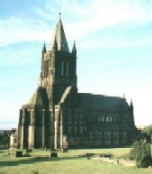|
|
FUGUE:
CHAPTER III
EDMUND
SCHULZE AND THE ORGAN AT MEANWOOD TOWERS
|
The
organ at Meanwood Towers, designed by Pugin the younger, stood in
the grounds 110feet NE of the SE corner of the mansion, but no
trace of it now remains. It appears on the plans of 1925 and 1940,
but not on that of 1946, the site now being occupied by No. 29
Towers Way, and the whole width of the road fronting No. 29. In
the plan, as shown on the deeds of the property, it was an
irregular Latin cross measuring externally 65 feet in length and
44 feet in width, the central aisle being 21 feet wide. The latter
width corresponds to the final internal measurement of 20 feet
given by Kennedy in July, 1868, as the space available for the
organ.
In
Albutt’s words:
|

|
The
First Recital
Naturally,
when the organ was complete, the Kennedy’s wished to have a
formal “opening” by some great exponent of the
instrument, and Samuel Sebastian Wesley, organist of Gloucester
Cathedral and foremost amongst catherdral organists of his day,
both as composer and performer, was the obvious choice because of
his earlier connection with Leeds. Great nephew of John Wesley,
the founder of Methodism, grandson of Charles Wesley the hymn
writer, and son of Samuel Wesley, a brilliant organist and
composer, the young Samuel Sebastian was appointed organist of
Hereford Cathedral in 1832, aged 22. He moved to Exeter Cathedral
in 1835, but was frustrated and constantly in dispute with the
Dean and Chapter, owing to the low ebb to which English cathedral
music had sunk at that time. In 1842, at the invitation of Dr.
Walter Farquhar Hook, Vicar of Leeds, Wesley became the first
organist (but not choirmaster) of the rebuilt Leeds Parish Church,
where he established the high standard of choral and organ music
for which the church has ever since been famous. He brought with
him the young William Spark, later to become the first City
Organist of Leeds and a great admirer of the Armley Schulze organ.
The choirmaster from c.1845 was Robert Senior Burton, who
succeeded Wesley as organist in 1949, and, in later years,
together with Leeds Parish Church Choir, took part in the opening
of the Schulze organ both at Harrogate and Armley. His association
with Wesley at Leeds was not a happy one, owing to a conflict of
personalities.
Wesley
was only persuaded to give the opening recital with considerable
difficulty, as he was unwilling to play before a party of guests,
and it was only on the hard condition that no one should be
present except Mr. and Mrs. Kennedy, Schulze and Allbutt, that the
master consented to play at Meanwood Towers. Allbutt describes the
recital thus:
|
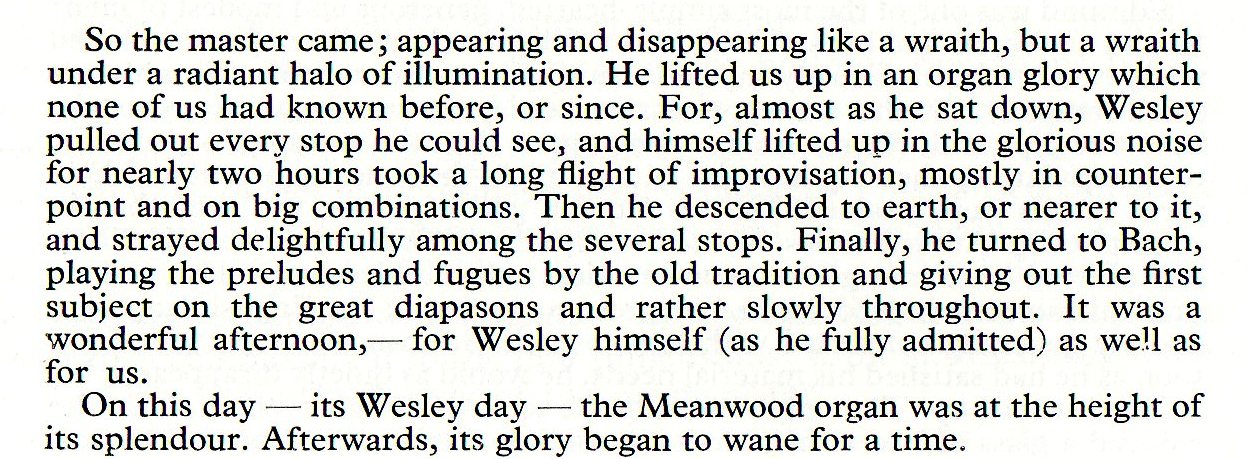
|
|
The
Specification of the Original Organ
The original case,
stop action, pneumatic lever and tracker actions, keyboards,
pedals, hand-blowing and hydraulic-blowing equipments have all
vanished, and of the original console only the stop knobs (with
two exceptions), the stop jambs and the organ bench remain.
Preserved for many years by J. J. Binns in the voicing room of the
factory at Bramley, the stop knobs, mounted on the original jambs,
were acquired by the Leeds Corporation in 1953 (when Messrs.
Binns, Fitton & Haley, successors to J. J.
Binns, closed down) for the Kirkstall Abbey Abbey House Museum,
Kirkstall, Leeds, but were only exhibited there for a very short
time, being stored elsewhere until 1975, when they were only
located with considerable difficulty and returned to the organ
loft at Armley.
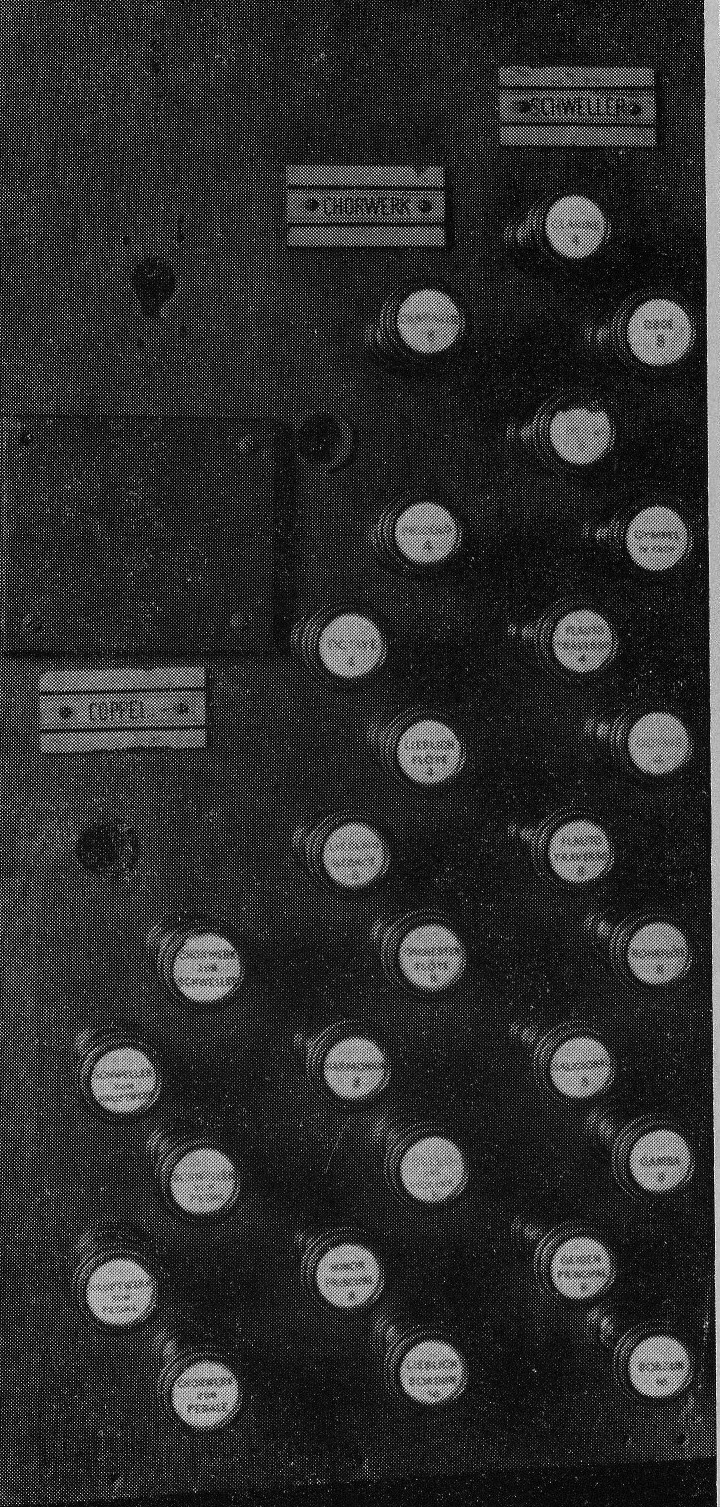 The
original left-hand stop jamb
The
original left-hand stop jamb
from the Meanwood Organ.
|
Left
and right, are the original straight stop jambs on which the
stop knobs are now mounted in what is not necessarily the
original order, but these afford the only authentic record of
the original specification of the organ.
The
knobs are turned from rosewood to a uniform pattern, including
those of the two pedal stops added in 1879. Inset in the
face of each knob is a glazed white ceramic plate bearing the
name and pitch of the stop (or coupler) in English block
letters (right). The knobs have evidently suffered
many accidents, two plates being so damaged as to be illegible
(Trompete of Hauptwerk and Horn of Schweller), whilst many are
cracked and two knobs have vanished entirely (Cornett of
Chorwerk and a coupler of unknown function). The names on the
plates are in many cases well preserved in black characters,
but others are very faded, although still legible.
Since
the latter are distributed in a random manner over the jambs,
it seems unlikely that the fading is due to the action of
light, but rather that Messrs. Schulze & Sons obtained the
plates in batches, as required, and that the present set
includes plates from at least two batches differing in
permanence.
|
 The
original right-hand stop jamb from
The
original right-hand stop jamb from
the Meanwood Organ.
|
The
plates of the Metal Principal Bass 16ft. and Sub Bass 32ft. are
clearly different from the remainder of the Pedal stops, being of
a more opaque white ceramic base and inscribed in different
characters. When these two stops were added in 1879, the double
row of Pedal stop knobs was extended and, to accommodate the
additions, the plate inscribed "Pedal" was moved upwards
on the jamb, the old screw holes remaining visible.
The
right jamb includes the brass pulley for the "tell-tale"
and the left jamb has a roughly-cut hole, now covered by an oak
patch, which probably contained the starting valve for the
hydraulic engine.
The
rectangular plates denoting the various departments of the organ,
Hauptwerk, Echo and Pedal on the right jamb; Coppel, Chorwerk and
Schweller on the left jamb, were probably painted white originally
(now yellow with age), with the name of the department in large
black letters between horizontal red and black lines.
Affixed to the jamb by the original brass screws, these plates
have a most unorthodox appearance to the eye accustomed to the
neat ivory plates of the English console.
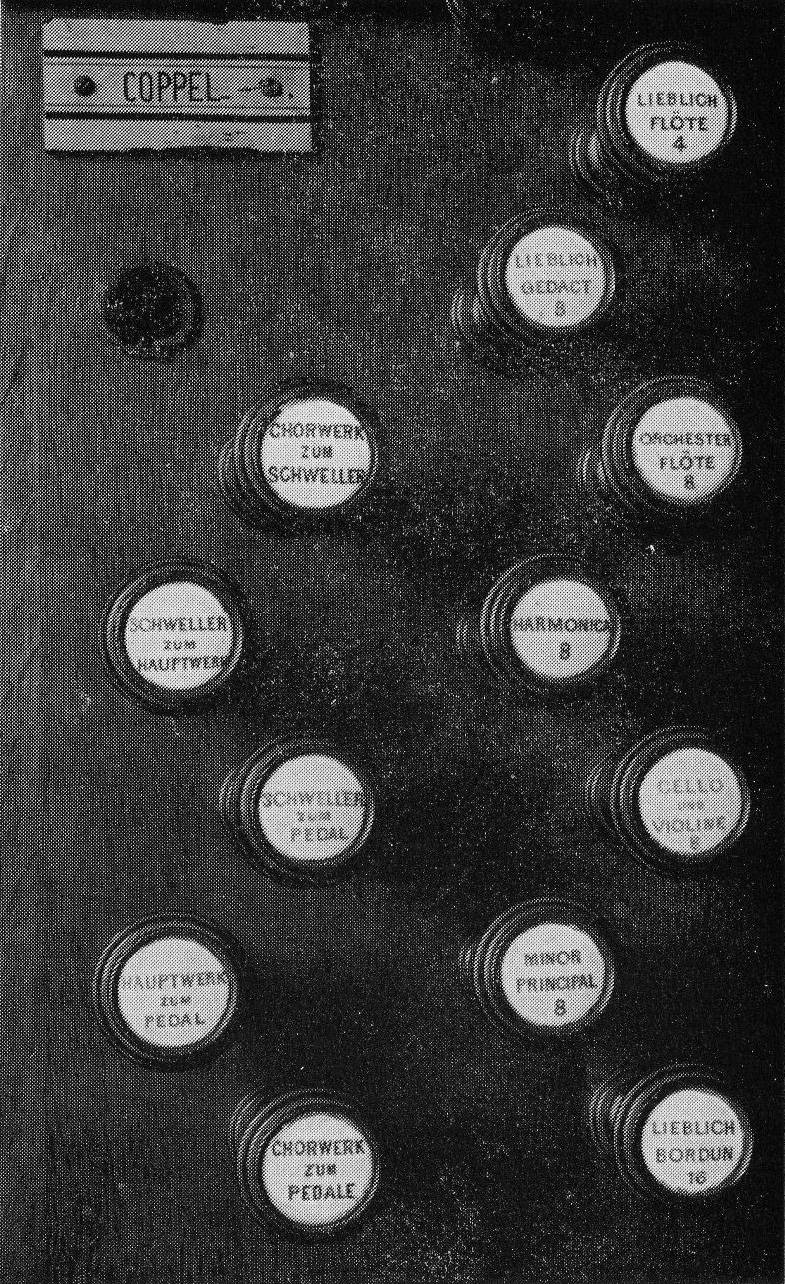 The
group of couplers from the
The
group of couplers from the
left jamb
|
The
workmanship of the jambs appears rough by comparison with the
Binns console now in use, and the massive stop knobs (1.7 in.
in diameter and 2.7 in. long) each attached to an oak stop rod
0.85 in. diameter, and with a long straight draw, must have
rendered changes in registration very difficult whilst playing,
unless assisted. It is by no means certain that the ceramic
plates, or even the stop knobs, are of German origin, since in
a letter to Kennedy of 26th June, 1868, Messrs. Schulze &
Sons wrote:
“We
quite agree with you that it is better to obtain the little
plates and knobs for
the stops in England. But there is
plenty of time to order these when our
Edmund comes to
visit you”.
The
readable stop knobs on the jambs present some problems. The
stop knob shows the Mixtur of the Hauptwerk (Great Organ) as
having five ranks when the organ arrived at Armley, which is
confirmed by the Press specifications of the organ when at
Harrogate and when removed to Armley. Similarly, the
Rausch Quinte appears as a two-rank mixture (II
fach) with the two ranks drawn together, as at present.
It is therefore very singular that, in the two Press
specifications mentioned above, the ranks are described as
being drawn separately, and as Twelfth and Fifteenth in one
case, but as Octave Quinte and Superoctave in the other case.
Further, the latter nomenclature is repeated both on the sheet
printed for the opening of the organ in 1879 entitled:
“Description
of the Organ in St. Bartholomew’s, Armley, the gift of
H.W.Eyres, Esq.
Built by Edmund Schulze, of Paulinzelle,
Germany (erected by Messres. Brindley & Foster)”
and
as late as 14th August, 1889, in the specification printed with
the programme of a recital given by Mr. T. Cawthra. Since
the Press specifications differ in the stop nomenclature used,
it is probable that they were both in error when written, due
to inaccuracy in recording the legend on the stop knob and
subsequent correction to correspond with organ design customary
in this country.
|
|
An
original stop knob from the Swell, turned from rosewood and
with a glazed white ceramic name-plate inset, bearing the name
in English block letters but retaining the German nomenclature.
|
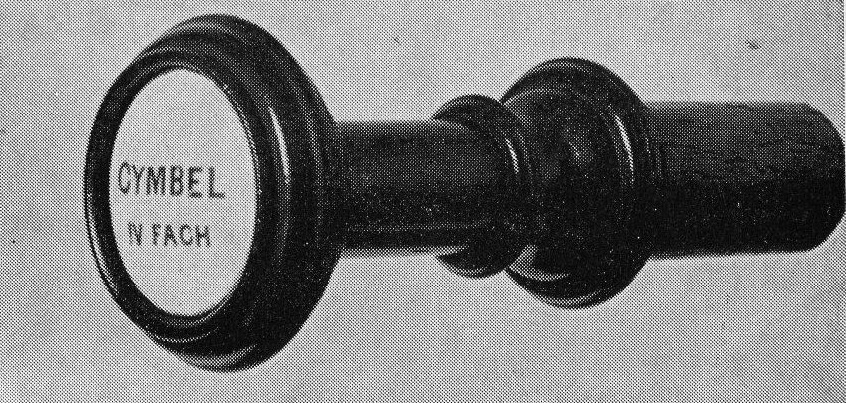
|
Fortunately
this point is made clear by the writings of Dr. William Spark,
City Organist of Leeds, who wrote a series of articles on "Sunday
Musical Services in Leeds," published "in a weekly
contemporary" c. 1885. Cuttings of the third article,
preserved with the Armley Church records, deal with the services,
choir and organ of St. Bartholomew's. In the specification
of the organ, the stop nomenclature has been greatly altered by
Spark to conform with English usage (e.g. "Open Diapason"
in place of Major Principal; "Dulciana" in place of
Dolcissimo) and the Piccolo of the Choir Organ is incorrectly
stated to be of 2ft. pitch, but in the Great Organ stop No. 9
is clearly described as "Twelfth and Fifteenth (on one slide)
2⅔ft. and 2ft." Finally, examination of the
Great Organ soundboard, which appears to be original, shows that
the Rausch Quinte slider is too narrow ever to have allowed
separation of the two ranks, and it is in any case most unlikely
that any organist would have had them united as a two-rank mixture
if they had been separate originally.
The
couplers present a problem made more difficult by the fact that
one stop knob is missing from the coupler group. The Press
specifications of the organ at Harrogate and when first at Armley,
the specification printed for the opening of the organ in 1879,
and that included with the recital programme of 1889, all agree in
listing five "Coppel" i.e. couplers:
-
1. Hauptwerk zum
Scheller 2. Chorwerk zum Scheller 3. Hauptwerk zum Pedal)
4. Scheller zum Pedal)
5. Chorwerk zum Pedal
|
|
(Great to Swell)
(Choir to Swell) (Great to Pedal) (Swell to Pedal) (Choir
to Pedal)
|
Of
these, Nos. 2, 3, 4 and 5 remain on the stop jamb , although in
the case of No. 5 the spelling "Pedale" is inconsistent
with the remainder. No. 1 is replaced on the stop jamb by a knob
carrying the reversed
legend Schweller zum Hauptwerk - the normal
Swell to Great coupler in England, and a sixth coupler is assumed
to have occupied the vacant hole in the jamb, which appears to be
original. There is no evidence of any removal of the name plate
"Coppel" above the coupler group to a fresh position on
the jamb and the grouping of the knobs suggests strongly that
there were originally six couplers present. Since the early
Schulze specification of 6th October, 1866, included both Oberwerk
to Grosswerk and the
reverse coupler Grosswerk to Oberwerk, it is consistent to assume
that the missing coupler on the stop jamb was Hauptwerk zum
Schweller, as listed in the Press and other specifications.
If
this were so, it is difficult to understand the omission of the
Schweller zum Hauptwerk coupler when the specification was
recorded. Another possibility, suggested by Mr. J. J. F. Watkins,
a former organist of the church, is that the missing coupler was
Chorwerk zum Hauptwerk. The ceramic plates of the coupler
knobs show the variation in permanence of the lettering described
above, not all being of one batch, and it is not possible to
exclude changes in the couplers on transfer of the organ to
Harrogate, or later to Armley, or even during the early years at
Armley.
Manual blowing equipment existed until the 1956
renovation at Armley, consisting of six feeder bellows operated by
two large hand wheels, the wind passing into a long wind chest on
the top of the mechanism, and thence into the main wind trunk
leading from the blowing chamber. Mr. Watkins witnessed the
removal of this apparatus in February, 1956, and found from the
condition of the interior of the feeders that they had been very
little used. He considered that four men would have been
required to blow the organ.
Although
only hydraulic blowing equipment is mentioned in the German
correspondence, the rather primitive manual apparatus described
may well have been provided by Messrs. Schulze & Sons, either
at Meanwood or on removal to Harrogate or to Armley. The
great Schulze organ at Doncaster Parish Church was provided with a
larger blowing mechanism operated by the weight
of the men so employed!
The
following is the specification of the organ as it is believed to
have been built at Meanwood Towers, derived from a comparison of
the original stop jambs and knobs, removed by Binns in 1905, with
the recorded specifications mentioned above. The stop
nomenclature is exactly as shown on the original knobs, with the
addition of the Chorwerk Cornett II-V fach, of which the knob is
now missing, completion of the legends on the damaged knobs and
correction of the "Chorwerk zum Pedale" error. Two
alternative suggestions are included for the missing coupler.
|

|
|
|
|
|
